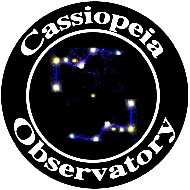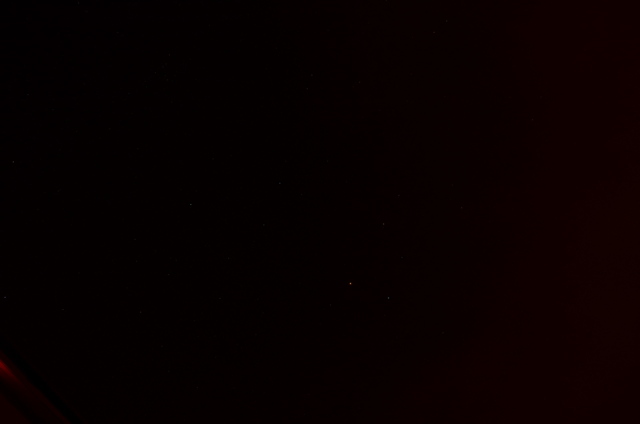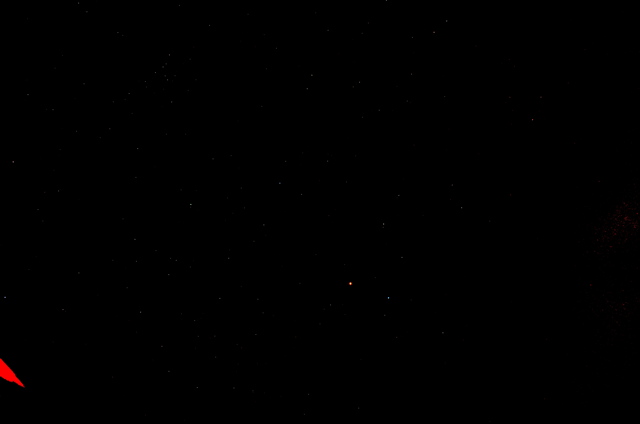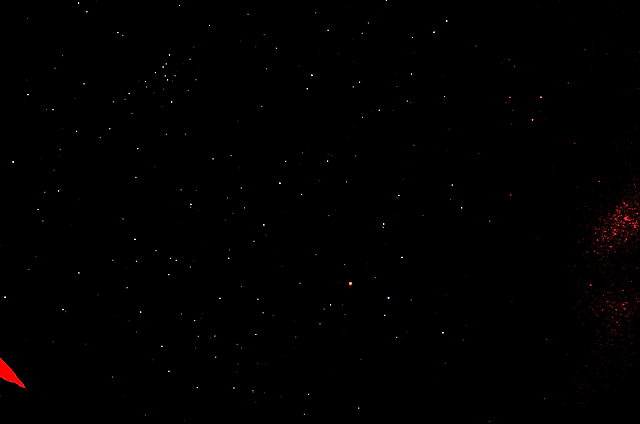
ASTROPHOTOGRAPHY - TIPS
Last updated: 27 April 2012
This page documents astrophotography comments, tips, and photos. Contributions welcome. Be certain to see the other articles on the main Astrophotography page.
Subject: Astrophotography with Nikon D5100 Sent: Thursday, April 26, 2012 14:09:06 From: Jim Beston (james_beston@sky.com) I took a few photos of Mars with my Nikon D5100 a couple of days ago, playing about with various settings of ISO and exposure. There was some cloud about but the seeing was quite good between them. I have a very little knowledge of image processing generally "trial and error" is my method (but I'm learning!) I took one of the better images and made some adjustments to the levels and curves using "The Gimp." I attach before and after processing. I was very much surprised at the detail that this simple processing revealed and I would be very much obliged if you could advise me if I could, by the use of additional processing tweaked a bit more out of it. This was only a single exposure of 5 seconds at ISO 400 at f5. I have yet to determine the effects of exposure vs ISO as usual, just as I got enthusiastic the cloud came over. Our local council has been kind enough to place two large sodium street light in front of our house so, despite being around the back of the house there was an orange tint to everything due to reflection of the house walls and clouds. The orange chevron at the bottom left is the fascia just below the house roof. Odd that that is obviously enhanced, when I removed the orange glow in the image during processing. Kindest Regards Jim



Subject: Question about Maxview DSLR unit Sent: Monday, April 2, 2012 14:02:39 From: Rick Stingle (zytech@wavecable.com) I have followed your website for many years now and have to say that the mighty ETX lured me into astronomy. If fact, I still have an EXT80 sitting on a shelf in my office. Nowadays I use a wedge mounted 8" LX90 UHTC and a William Optics 80mm ZS ED-II guidescope. My wife tells me that I have become badly infected by the astrophotography bug! I just reviewed the Maxview DSLR II page of your website. Wondering what you NOW think of that monster. I am debating if I should go that route because I own a large number of nice 2" eyepieces or if I should continue looking for an Easter Basket full of TV Powermates & T-Adapters ....... HA I allready own a Meade 1-1/4 Eyepiece Projection device but feel that 2" eyepieces would produce far better photos of the moon and planets. I use an unmodded Canon T2i 550D DSLR on my telescopes. What's your opinion on this "magnification hardware" subject?????? KUDOS for all you have done for astronomy, Rick Stingle; Port Orchard, WA.Mike here: I really liked the MaxView but it was stolen in 2007 along with a lot of my equipment. As to getting one today, see the Other: Editorial Page for comments on Scopetronix and CNC Parts Supply.
Subject: Polar mode, scope weight and slipping gears when slewing? Sent: Wednesday, March 14, 2012 06:15:39 From: Garth B. (garthb@gmail.com) I've looked around for this on your site but nothing jumped out at me. I've made the leap into rudimentary astrophotography with a 1st gen Canon Rebel hanging off the back of my ETX 125AT. I set the mount up in the necessary equatorial configuration, but ran into a strange problem during alignment (and then subsequent go-to operations). At certain angles, when the scope is slewing on the polar axis (I guess what would otherwise be the azimuth motor), the motor runs but the scope stops moving. It almost seems as though the scope is too heavy for the motor to move, but I hear no strain from the motor. The scope starts to move on the polar axis, but then stops even though the motor is continuing to run. If I give the scope some gentle pressure with my finger in the direction it was trying to go, it will freely move in that direction. It almost seems like it needs a helping hand moving the heft of the OTA. This happens with and without the camera hanging off the back. It isn't hitting a hard stop. It seems to mostly happen when the scope is trying to sweep "up" and over. I've experienced no issues when slewing on what would otherwise be the altitude axis. Could the gearing inside be slipping or something? I don't seem to have this issue in the regular alt/az mode. The azimuth clutch feels like it engages firmly. Thank you for any advice you may have (or pointers to resources on your site I missed)! GarthMike here: The problem is simple: the ETX was not designed to handle a lot of extra weight. The solution is (somewhat) simple: add a counterweight. A more complicated solution is to add a counterweight system that works in all orientations. You can counterweight articles on the Helpful Information: Astrophotography page. An alternative that can help in some orientations is to mount the camera using the eyepiece holder and a suitable camera adapter. I use the OPT Camera Adapter (see the Accessory Reviews: Astrophotography page) with my Nikon D7000 DSLR.
And:
Thanks Mike! Glad to know this expected behavior. I like a lot of these counter balancing ideas. What I wasn't able to find, however, was how to actually determine when the scope is counter balanced. I assume, for now, that it's simply a matter of having the scope maintain a level position when horizontal (like a see-saw) when a camera is attached to the rear. Coincidentally, I was just notified by my significant other that a used DSI II has come into the market for what I think is a reasonable price ($150). Perhaps this will make the need to counter balance moot. Do you have any knee jerk reactions to astrophotography with a DSLR vs. a dedicated CCD like the DSI II? (or any reaction to the DSI II, in general?) Thanks again! GarthMike here: Proper balance is determined by loosing both axis locks with the camera mounted. If there is ANY movement, the system is not balanced and the counterweight(s) need to be adjusted. Some people like a slightly heavy tendency to the east to help with the gears. As to dedicated imager vs DSLR, certainly the dedicated imagers and appropriate software will yield better images. But you need a computer at the telescope. With a DSLR, you can do some amazing astrophotography and you don't need the computer at the telescope.
Subject: Question on the ETX-70... Sent: Tuesday, March 13, 2012 08:55:47 From: Greg Perugini (greg@perugini.com) I have a very old and well used LX-200 scope (classic 10"), that has given me great value over the years. I have inherited a ETX-70, and everything I read seems to point to putting a new front end on the thing if I want it to be used as an off-axis guider. Couldn't I just remove it from the fork and mount it with rings on the LX-200, leaving the back end on? I was going to place my Deep Sky into the eyepiece and connect the DSI to my computer, having it autoguide the system. Does this make sense? Thanks for your time, and for hav a great resource for the ETX owners. GregMike here: You can (with some difficulty) remove the OTA from the fork arms and mount it on the LX200 using tube rings and an adapter plate. It would make an excellent guidescope. See the "ETX-70AT Repair Guide" on the Helpful Information: Telescope Tech Tips page for info on removing the OTA.
Subject: eyepiece projection basics Sent: Sunday, March 11, 2012 19:53:05 From: ben tetzner (b.tetzner@yahoo.com) Great site with lots of information. I have started doing photography through my etx 125, but there seems to be alot of misleading information out there. I want to do eyepiece projection photography,but most of the adpters do not seem to be recommended for the etx 125. Is there an adapter specifically for this scope? I appreciate your help. Thanks, BenMike here: See the article "Astrophotography Types" on the Helpful Information: Astrophotography page. I discuss eyepiece projection and an adapter there.
Subject: ETX 90 Declination backlash Sent: Tuesday, March 6, 2012 07:35:21 From: Paul Smith (Paul.Smith@twinhillsiron.com) I recently attached my DSLR to my ETX 90 and noticed a considerable amount of backlash (slop) on the declination axis. I did not see anything relating to this on your site. Rather than tear in to this, I thought I should ask first. Is there a way to correct this? Thanks, PaulMike here: Actually, this is discussed a lot on the ETX Site. The additional weight from the camera is causing the problem. The ETX was not designed to handle a lot of extra weight. However, you can correct for the problem but adding a counterweight system. See the Helpful Information: Astrophotography page for many articles on counterweights.
Subject: ETX 70 plus Canon DSLR plus 300mm telephoto lens Sent: Tuesday, February 21, 2012 22:11:11 From: Debbie Funk Sywak (dsywak@gmail.com) Hi there, I am looking for some advice on what equipment I need to purchase so that I can attach my Canon Rebel XTI with telephoto lens (300mm) to my ETX 70 Telescope and achieve the best quality photos. Will The camera lens provide additional magnification attached to the telescope or is this not possible? I love your website, thanks for your help. Kind regards, Debbie Funk SywakMike here: I am in my observatory preparing to image M63. Short answer: see the current Astrophotography Tips page on the Helpful Information: Astrophotography page. I answered a similar question there (further down this page).
And:
Thank you. I'll take a look. Happy Star Gazing!
Subject: etx 90 and canon eos 600d Sent: Friday, February 17, 2012 06:30:49 From: andy (mondeost155@live.co.uk) hi just want little advice , i have a meade etx 90 and a canon eos 600d now im new to both fields , ive seen i van attach the 2 with various bits of equipment theres a few things im unsure about and wondered if you can help . when all connected the mirror inside the telescope is flipped down so would the picture not be upside down i am assuming when all connected there will be no zoom facility you would only get one magnification would it be able to take pictures of say the moon and saturn the camera only has a 30 second shutter speed is this another problem thanks for any help andyMike here: Yes, you can do some types of astrophotography of the moon, planets, stars, nebulae, and galaxies with the ETX and your camera. See the Helpful Information: Astrophotography page for a lot of information. Also, see the Helpful Information: Astrophotography Gallery Archive for lots of examples of astrophotography done with the ETX models. See the Accessory Reviews: Astrophotography page for some reviews of camera mounting accessories. See the article "Astrophotography Types" on the Helpful Information: Astrophotography page to learn what types of astrophotography you can do. Depending on hou you mount the camera to the ETX, the position of the flip mirror will need to correctly position. For astrophotography, orientation of the image is less a concern than with terrestrial photography. However, if the resulting orientation bothers you, you can always adjust it in image editing software on your computer. When imaging at "prime focus" (see that article on astrophotography types), the telescope acts like a long telephoto lens. You can increase the magnification by using a Barlow Lens. With "eyepiece projection" (see the article), you get more magnification and more difficulties. Exposure time will vary with the object being imaged. Keep in mind that the ETX is not designed for long duration astrophotography. However, as you can see from all the examples on the ETX Site, you can get some amazing images with patience, experience, and some luck. I suggest starting with the moon and learn how to image using it.
Subject: Question from a reader Sent: Tuesday, February 7, 2012 07:55:19 From: Eric Atkins (e03179@gmail.com) I found your website while searching for an adapter that will secure my iPhone to telescope to capture images. Could I seek your advice via email? When I walked past a Celestron PowerSeeker 70AZ on clearance sale for just $40 at my local Wal-Mart, I couldn't pass it up. So, with that entry level telescope I have an iPhone 4 and a Nikon D7000. How should I capture images now? I'm interested in maxing out the capabilities of the telescope to capture wonderful images of the moon, Saturn, and Jupiter...with hopes of being able to see some deep space nebula. I can build my own iPhone adapter with parts from Lowe's and with use of old cases that I no longer use. Will I see a dramatic increase in quality of images if I mount my D7000 dSLR to the scope? I'm guessing the tripod for the telescope could be too weak since it is such a cheap build. Regardless of that, would the telescope's limited optical capabilities mean that using a D7000 would be overkill and I should just keep it simple with my iPhone (which, would be, of course, lighter weight and create less of a moment arm on the telescope and tripod). I'm new to astrophotography and have been reading your website. This is such an entry level telescope that I'm unsure if I should bother with a camera mount. I really just don't know what it is capable of with respect to my camera equipment. Long exposures on the D7000 would be great but will I see much of a benefit versus the iPhone's sensor? Thank you for your time and I hope for a reply. BTW: Here was my first capture freehanding the iPhone last night with a 20mm eyepiece: http://instagr.am/p/o48mc/ Thanks! //EA (on the go. sent from a ₥obile de√ice.)Mike here: First, please read the Email Etiquette page on my ETX Site. Your message was originally DELETED UNREAD as SPAM due to the ambiguous subject. Thanks for understanding.
Subject: filter question Sent: Tuesday, January 17, 2012 04:40:39 From: Jim Beston (james_beston@sky.com) I am trying to find a way of putting a LPR filter in the light path. The camera attaches to the focal reducer via the usual T-connector and T ring. I had assumed that I could get a LPR filter that screwed into the T connector which is internally threaded. Apparently not because the Baader 2" LPR filter I purchased (on recommendation) is too big to go inside the connector and does not fit anywhere else in the light path. It seems it is designed to screw into the end of a 2"" eyepice. After talking with my supplier (www.f1telescopes.com) who, incidentally I can highly recommend, It seems that I need to get a visual back and a "sliding-tube" adaptor that fits in the visual back and carries also the T-ring adapter for my camera. This is being investigated. It seems very complicated and I wonder if there is an easier way. Michael Covington in his excellent book "Digital SLR Astrophotography (7th printing 20011) shows (p54) a filter sitting between the rear cell of the telescope and the T-adapter connected to the rear cell. In the case of the LX200 GPS the rear cell fitting is larger than 2" and the first attachment is the Meade adapter that reduces the cell thread to a standard 2" SCT. Then I have the Meade microfocuser and then (usually) the Meade f 6.3 focal reducer. I believe in earlier correspondence (which I have lost) you indicated that there were filters available that fitted in the T-connector. There must be very many of your correspondents who do DLSR astrophotography and who do use filters. I would be very interested to learn how they insert them! Thanks and Regards JimMike here: I previously mentioned that I use the OPT Camera Adapter, which accepts 1.25" filters. If your adapter is 1.25" you should be able to use 1.25" filters.
Subject: Re: Re: Astrophotography question Sent: Monday, January 16, 2012 08:56:46 From: cjewell.rvt@gmail.com (cjewell.rvt@gmail.com) Final question, how can you tell what reducer you would actually need? I see Meade f/3.3 or f/6.3. From what I have seen so far the f/3.3 seems more CCD sized. In your experience is one manufacturer product better than another for the ETX-125? Thanks againMike here: There are limited focal reducer options that will attach directly to the ETX. I don't have any experience with the f/3.3 focal reducers (on any telescope) but I do frequently use a f/6.3 on my 8" telescope. Unless you want to try for really large and/or faint objects, I'd recommend sticking with f/6.3 for an ETX. I use my Shutan Wide-Field Adapter (originally by Apogee and no longer available) on my ETXes. It works nicely.
Subject: Astrophotography question Sent: Saturday, January 14, 2012 21:15:06 From: Chad Jewell (cjewell.rvt@gmail.com) I recently purchased a used Meade DSI Pro CCD camera that I should receive this coming week. I also have a couple "homemade" LPI webcams ( HD and non-HD ) that I trying to tweak. One question that I have - Is a Focal Reducer needed or only beneficial? I looked through your Astrophotography link and couldn't find much talking about them. I am pretty sure that it would be beneficial but can you survive part of the learning curve without them. Also, if they are really needed what is your recommended reducer? My second question is I have only had a very short moment of time to play around with my non-HD LPI. I was trying to get a snippet of Jupiter but the .avi was severely bright. I was in the process of adding the moon filter and focusing but the clouds rolled in and haven't rolled out in weeks. Would the focal reducer assist with the brightness issue here as well? I would love to try again tonight as the clouds are out but at -0.8 degrees I'll wait. As always, I appreciate all your help you have provided. Thanks and have a great night, ChadMike here: A focal reducer will make a telescope optically faster, meaning objects will appear brighter, albeit with less magnification. A focal reducer will generally allow fainter DSOs to be imaged. It will also increase the field of view, allowing larger objects to be imaged. Is a focal reducer required? No, but it useful for many objects. Will it help with planets? No. Using a moon filter will help though. See the Accessory Reviews: Astrophotography page for some reviews.
And:
Thanks for your advice.
Go to the October-December 2011 Astrophotography - Tips page.
Go to the July-September 2011 Astrophotography - Tips page.
Go to the January-June 2011 Astrophotography - Tips page.
Go to the April-November 2010 Astrophotography - Tips page.
Go to the January-March 2010 Astrophotography - Tips page.
Go to the April-December 2009 Astrophotography - Tips page.
Go to the January-March 2009 Astrophotography - Tips page.
Go to the May-December 2008 Astrophotography - Tips page.
Go to the February-April 2008 Astrophotography - Tips page.
Go to the July-December 2007 Astrophotography - Tips page.
Go to the January-June 2007 Astrophotography - Tips page.
Go to the October-December 2006 Astrophotography - Tips page.
Go to the July-September 2006 Astrophotography - Tips page.
Go to the April-June 2006 Astrophotography - Tips page.
Go to the January-March 2006 Astrophotography - Tips page.
Go to the November-December 2005 Astrophotography - Tips page.
Go to the September-October 2005 Astrophotography - Tips page.
Go to the July-August 2005 Astrophotography - Tips page.
Go to the May-June 2005 Astrophotography - Tips page.
Go to the March-April 2005 Astrophotography - Tips page.
Go to the January-February 2005 Astrophotography - Tips page.
Go to the October-December 2004 Astrophotography - Tips page.
Go to the July-September 2004 Astrophotography - Tips page.
Go to the April-June 2004 Astrophotography - Tips page.
Go to the January-March 2004 Astrophotography - Tips page.
Go to the 2003 Astrophotography - Tips page.
Go back to the Astrophotography Page.
Go to the ETX Home Page.